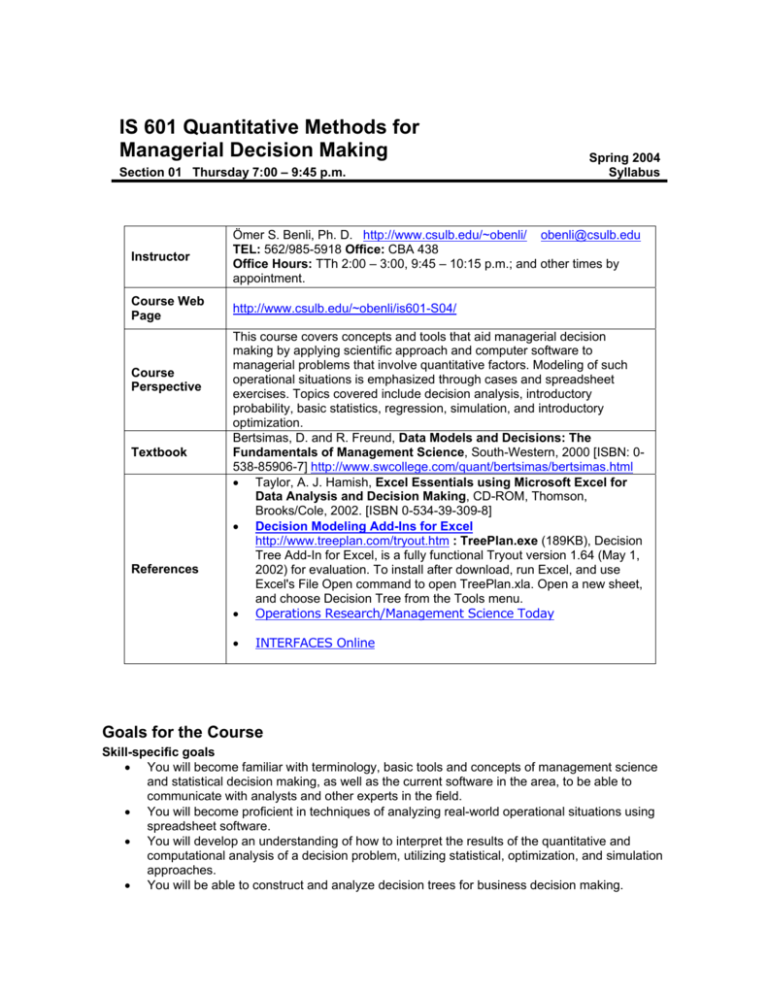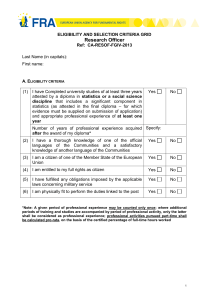IS 601 Quantitative Methods for Managerial Decision Making
advertisement

IS 601 Quantitative Methods for Managerial Decision Making Section 01 Thursday 7:00 – 9:45 p.m. Spring 2004 Syllabus Instructor Ömer S. Benli, Ph. D. http://www.csulb.edu/~obenli/ obenli@csulb.edu TEL: 562/985-5918 Office: CBA 438 Office Hours: TTh 2:00 – 3:00, 9:45 – 10:15 p.m.; and other times by appointment. Course Web Page http://www.csulb.edu/~obenli/is601-S04/ Course Perspective Textbook References This course covers concepts and tools that aid managerial decision making by applying scientific approach and computer software to managerial problems that involve quantitative factors. Modeling of such operational situations is emphasized through cases and spreadsheet exercises. Topics covered include decision analysis, introductory probability, basic statistics, regression, simulation, and introductory optimization. Bertsimas, D. and R. Freund, Data Models and Decisions: The Fundamentals of Management Science, South-Western, 2000 [ISBN: 0538-85906-7] http://www.swcollege.com/quant/bertsimas/bertsimas.html • Taylor, A. J. Hamish, Excel Essentials using Microsoft Excel for Data Analysis and Decision Making, CD-ROM, Thomson, Brooks/Cole, 2002. [ISBN 0-534-39-309-8] • Decision Modeling Add-Ins for Excel http://www.treeplan.com/tryout.htm : TreePlan.exe (189KB), Decision Tree Add-In for Excel, is a fully functional Tryout version 1.64 (May 1, 2002) for evaluation. To install after download, run Excel, and use Excel's File Open command to open TreePlan.xla. Open a new sheet, and choose Decision Tree from the Tools menu. • Operations Research/Management Science Today • INTERFACES Online Goals for the Course Skill-specific goals • You will become familiar with terminology, basic tools and concepts of management science and statistical decision making, as well as the current software in the area, to be able to communicate with analysts and other experts in the field. • You will become proficient in techniques of analyzing real-world operational situations using spreadsheet software. • You will develop an understanding of how to interpret the results of the quantitative and computational analysis of a decision problem, utilizing statistical, optimization, and simulation approaches. • You will be able to construct and analyze decision trees for business decision making. IS 601 Spring 2004 Course Syllabus Content-specific goals • You will gain an appreciation for the relevance and power of quantitative tools for managerial decision making. • You will develop an understanding of what decision technologies can and cannot do in support of decision making in business. • This course also aims to help you further refine your analytical thinking skills. Class Policy • • • Students with Disabilities: It is the responsibility of students with disabilities to inform the instructor within the first two weeks of the semester of the need for reasonable accommodations of their disabilities. Students are advised to seek assistance from Disabled Student Services (DSS) on campus. As soon as the need for accommodation is determined by DSS and the need is communicated to the instructor by DSS, reasonable accommodation will be made. If you use the same seat in class, starting with the second week of classes, it will make it easier for me to know your names and record attendance. I expect you to attend classes regularly and responsible for all materials covered in class, regardless of your attendance. Make-up exams are highly discouraged and will only be given with documented proof of an excused absence. Please give the earliest possible notification of an anticipated excused absence. Course Requirements • Examinations: There will be two 60-minute in class exams and a final exam. Each exam will cover only the material indicated. All exams are closed book and closed notes. However, you can bring one hand-written sheet of paper. (For dates, please see the course outline.) o Exam 1 Decision Analysis and Probability (50 points) o Exam 2 Statistical Analysis (50 points) o Final Exam Optimization (60 points) • Assignments: There will be three computer-based assignments and a writing assignment. You will be asked to turn in your assignments via BeachBoard. (For deadlines, please see the course outline.) o #1 A decision tree problem (20 points) o #2 A statistical analysis problem (20 points) o #3 A simulation problem (20 points) o #4 Writing assignment: review an article from the Interfaces journal (http://www.interfaces.smeal.psu.edu/) or Operations Research/Management Science Today (20 points) • How are the course grades determined? The maximum number of points for the course is 240. With the highest overall score in the class establishing the 100% benchmark, the course letter grade will be based on cumulative totals as follows: A 90 – 100% Grading Scale B C 80 – 89% 70 – 79% D 60 – 69% F Below 59% Course outline, suggested problems, and assignments, as well as other supplementary material, will be available on the course BeachBoard site. 2





